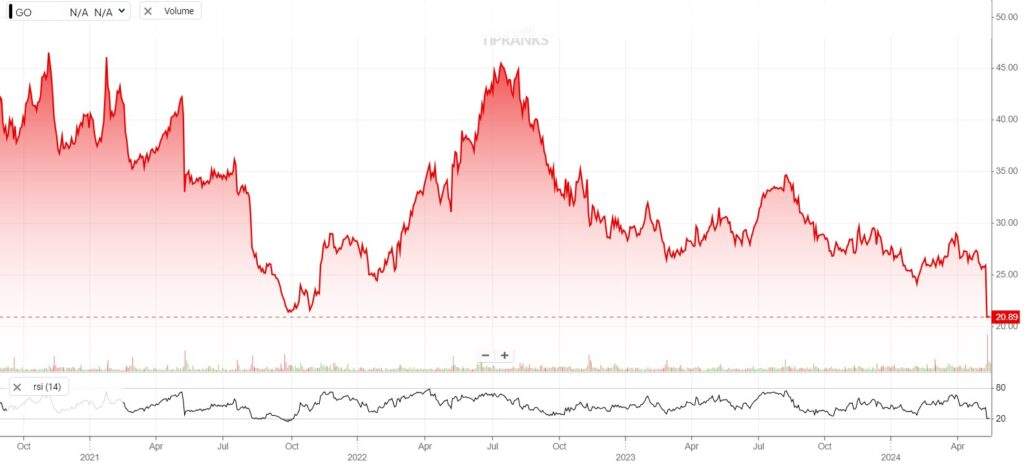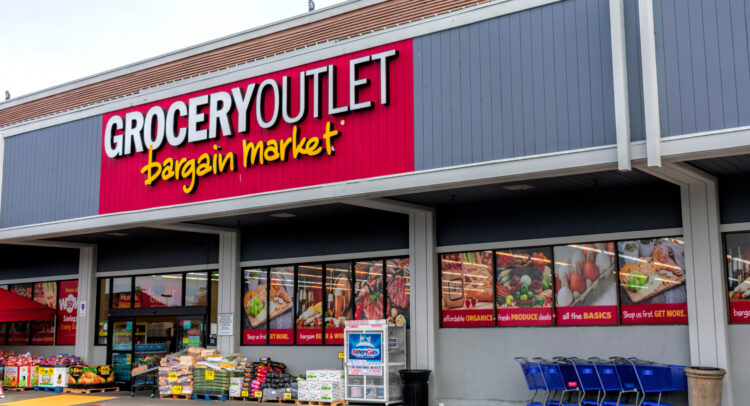As a retailer of various food products sold at reasonable prices, Grocery Outlet (NASDAQ:GO) is a secular stock that looks ripe for the picking. Amid a still-challenging economic environment, the idea of buying the necessities at relatively low cost resonates with hurting households. Therefore, despite the terrible drop in equity value due to a poor earnings report, the grocer just might make a high-risk, high-reward case for itself. I am bullish on GO stock as a possible recovery play.
Look Before Leaping Into GO Stock
In ordinary circumstances, I believe it’s usually best to avoid publicly-traded enterprises that have suffered double-digit percentage losses over a single trading session. Generally, such red ink implies that both proponents and covering analysts completely misread the opportunity. Further, it’s also possible that the target enterprise’s biggest institutional supporters have left for greener pastures.
For GO stock, the underlying company’s performance wasn’t a complete miss. In the first quarter of Fiscal 2024, Grocery Outlet generated revenue of $1.04 billion. This tally beat the consensus target of $1.02 billion. Further, comparable store sales increased by 3.9%, boosted by a 7% lift in the number of transactions.
However, problems started to arise when the spotlight moved to the bottom line. Adjusted earnings per share landed at nine cents, well off the expected EPS of 18 cents. In nominal terms, the company reported an unadjusted loss of $1 million in Q1, or a loss of one cent per share.
As well, management stated that it expects full-year earnings to land between 89 cents and 95 cents per share. On the top line, sales could reach between $4.3 billion and $4.35 billion. This is where the market took GO stock to the woodshed. Previously, analysts called for Fiscal 2024 EPS to land at 92 cents on revenue of $4.35 billion.
Tellingly, the low-side estimate called for earnings of 87 cents on revenue of $4.32 billion. The company’s leadership team was effectively prepping Wall Street for a possible disappointment this year. To adjust to the new realities, GO stock got pegged down.
That’s not unreasonable. One of the risk factors of the bullish case for GO stock was that the increase in comparable store sales was partially offset by a 2.9% decrease in average transaction size. So, it’s possible that even in spending on essentials, people are cutting wherever they can.
Technical Case for Grocery Outlet Shares
Perusing through the technical sentiment scores for GO stock, the situation does not look favorable. Using the default one-day time period, all major indicators point to a Strong Sell rating. That’s not surprising, given that shares suffered a near 20% loss of value last week.
However, investors may want to consider a metric called the Relative Strength Index (RSI). According to TipRanks reporter Sheryl Sheth, the RSI is a “momentum indicator that shows whether a security is overbought or oversold. RSI is a technical indicator that works by measuring the speed and volume of the price movement of a stock.”
Without getting bogged down in the granularity of the RSI, the key takeaway is that it’s a contrarian indicator. In other words, the hypothesis is that if the RSI is oversold (a reading of 30 or less), shares could fly higher. Conversely, if the RSI is overbought (70 or more), the target security could be due for a correction.

Currently, the RSI for GO stock (the black line at the bottom of the chart) is sitting right on the 20 level, indicating that it’s significantly oversold. The last time the RSI was this oversold was in October 2021, when the reading was lower than 20. Following the printing of this statistic, Grocery Outlet shares went on a blistering run that peaked in July of the following year.
To be clear, it’s risky to assume that a similar situation can play out this time around. However, keep in mind that GO stock is a secular investment. No matter what happens in the economy (good or bad), people need to eat. Because of this reality, all other budgetary items may take a backseat. That’s why betting on this volatility might be more credible than if investors were wagering on a cyclical name.
It’s Solid Value, Too
At the moment, GO stock trades at 0.52x trailing-year revenue. That’s slightly undervalued compared to the grocery store sector’s average price-to-sales ratio of 0.54x. However, with sales projected to rise at minimum to $4.32 billion by the end of Fiscal 2024, the projected revenue multiple could be 0.48x.
Granted, GO stock might be more palatable as a short-term swing trade based on the low RSI than a long-term investment. Still, for those who want to take the long-term approach, it’s not unreasonable to believe that the high-side sales target of $4.41 billion is possible to reach.
Again, Grocery Outlet is a secular business. People need its products regardless of outside circumstances. Should the company pull off a small miracle, the sales multiple could decline to 0.47x.
Is Grocery Outlet Stock a Buy, According to Analysts?
Turning to Wall Street, GO stock has a Hold consensus rating based on four Buys, three Holds, and two Sell ratings. The average GO stock price target is $26.75, implying 28.05% upside potential.

The Takeaway: Necessity Could Drive Comeback for GO Stock
Generally, a beaten-down security should be avoided. However, Grocery Outlet presents an intriguing case because of its core secular business model. Because the company offers the essentials at a relatively low cost, GO stock presents a credible case for a comeback based on speculation because it is oversold. Further, its potentially undervalued profile just sweetens the narrative.
















